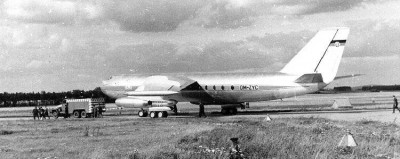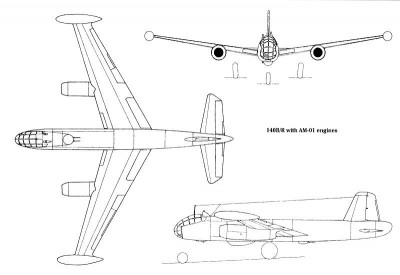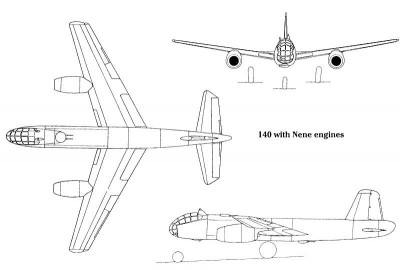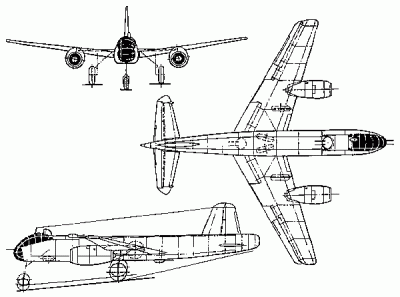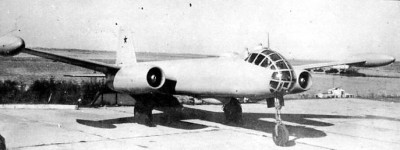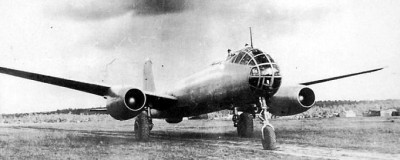| Název: Name: | OKB-1 140 | OKB-1 140 |
| Originální název: Original Name: | ОКБ-1 140 | |
| Kategorie: Category: | bombardovací letoun | bomber aeroplane |
| Výrobce: Producer: | DD.MM.1948-DD.MM.1948 Státní pokusný závod č. 1, Dubna | |
| Období výroby: Production Period: | DD.MM.1948-DD.MM.1948 | |
| Vyrobeno kusů: Number of Produced: | 1 | |
| První vzlet: Maiden Flight: | 30.09.1948 | |
| Osádka: Crew: | 4 | |
| Základní charakteristika: Basic Characteristics: | ||
| Vzlet a přistání: Take-off and Landing: | CTOL - konvenční vzlet a přistání | CTOL - conventional take-off and landing |
| Uspořádání křídla: Arrangement of Wing: | jednoplošník | monoplane |
| Uspořádání letounu: Aircraft Concept: | klasické | conventional |
| Podvozek: Undercarriage: | zatahovací | retractable |
| Přistávací zařízení: Landing Gear: | kola | wheels |
| Technické údaje: Technical Data: | ||
| Hmotnost prázdného letounu: Empty Weight: | 14676 kg | 32355 lb |
| Vzletová hmotnost: Take-off Weight: | 20796 kg | 45847 lb |
| Maximální vzletová hmotnost: Maximum Take-off Weight: | 25220 kg | 55601 lb |
| Rozpětí: Wingspan: | 19,40 m | 63ft 7,77in |
| Délka: Length: | 19,70 m | 64ft 7,59in |
| Výška: Height: | 5,70 m | 18ft 8,4in |
| Plocha křídla: Wing Area: | 58,40 m2 | 628.61 ft2 |
| Plošné zatížení: Wing Loading: | 356,10 kg/m2 | 72.94 lb/ft2 |
| Pohon: Propulsion: | ||
| Kategorie: Category: | jednoproudový | turbojet |
| Počet motorů: Number of Engines: | 4 | |
| Typ: Type: | Mikulin AM-TRDK-01 o tahu 29,42 kN | Mikulin AM-TRDK-01, thrust 6614 kN |
| Objem palivových nádrží: Fuel Tank Capacity: | ? | ? |
| Výkony: Performance: | ||
| Maximální rychlost: Maximum Speed: | 904 km/h v 3000 m | 561.7 mph in 9843 ft |
| Cestovní rychlost: Cruise Speed: | ? km/h v ? m | ? mph in ? ft |
| Rychlost stoupání: Climb Rate: | ? m/s | ? ft/min |
| Čas výstupu na výšku: Time to Climb to: | ? min do ? m | ? min to ? ft |
| Operační dostup: Service Ceiling: | 11000 m | 36089 ft |
| Dolet: Range: | ? km | ? mi |
| Maximální dolet: Maximum Range: | 2000 km | 1242.7 mi |
| Výzbroj: Armament: | 2x kanon ráže 20 mm v dálkově ovládané věži VDB-6 na hřbetě 2x kanon ráže 20 mm v dálkově ovládané věži NDB-1M na zádi 1500-4500 kg pum | 2x 20 mm cannon in the remotely operated VDB-6 dorsal turret 2x 20 mm cannon in the remotely operated NDB-1M tail turret 3307-9921 lb of bombs |
| Uživatelské státy: User States: | - | - |
| Poznámka: Note: | - | - |
| Zdroje: Sources: | Gordon, Yefim. Early Soviet Jet Bombers. Midland Punlishing, Hinckley 2004. ISBN 1-85780-181-4. Gordon, Yefim; Guston, Bill. Soviet X-Planes. Midland Publishing, Leicester 2000. ISBN 1-85780-099-0. ruslet.webnode.cz | |
OKB-1 140
The roots of this design go back deep into World War II. The machine follows a series of experimental aircraft by Junkers, aimed at testing the possibilities of jet propulsion of aircraft and a wing with a forward arrow, which was expected to reach speeds around Mach 1. The Ju 287 V2 was brought to the USSR unfinished in 1947. At that time there were already other machines of the fy. Junkers, and their creators.
The EF-140 was based on the Ju 287, which first flew in 1943. The aircraft was - to speed up construction - one big jigsaw puzzle: The fuselage came from a He 177 A, the tail surfaces from a Ju 388 and the landing gear even from a downed American Convair bomber B-24. The wings and engine installation were newly manufactured. The aircraft was gradually built in several variations of the number of engines - from 4 to 6 jet engines, and their placement was also debated. Usually under the wings and on the sides of the nose. During take-off, auxiliary Walter HWK 501 rocket engines were used with a thrust of 1200 kg for 40 seconds.
In the spring of 1945 the Red Army acquired a six-engine version of the Ju 287 V1 (4 JUMO 004B engines in bundles of 2 under each wing, 2 engines on the sides of the lower nose). Within 2 years, the machine was put through trials and the OKB-1 140 was developed.
The Soviet designation is partly based on the naming of the design in German documents, partly on the practice of referring to the design by the abbreviation of the design bureau. A design group of prisoners from fy. Junkers own office got also. The head of the new projects was Hans Wocke, the construction group was headed by Ing. Brunolf Baade, his deputies were aerodynamicist eng. Freitag and Petr Nikolayevich Obrubov. The work on the engines was directed by Dr. Schreibe, former head of the engine testing department of fy. Junkers.
Although the machine retained the basic concept of its predecessor, it was a completely new design by Ing. Baade. At first it was intended to be used as a long-range bomber, later, with the planned new engines, a photo reconnaissance role was added. The change of focus was also reflected in the markings, in the last version the machine bore the designation 140B/R (Bombardirovschik/Razvedschik).
The aircraft made its first flight on 15 March 1949, piloted by Wolfgang Ziesse, former chief pilot of Hermann Göring. This man had flown quite a lot in the USSR, as he had a lot of experience flying jet and rocket machines, for which he was very useful to the new masters.
Most of the work was done in connection with engines. Six German JUMOs of 900 hp were to be replaced by a pair of Soviet AM-TKRD-1 engines designed by A. A. Mikulin. In the role of long-range reconnaissance, the machine carried photographic equipment in the bomb bay and received 2 turrets with pairs of 23 mm machine guns for its defence. Control of the turrets was electric, remote by means of sighting periscopes. Each turret had its own gunner; if the upper gunner was disabled, his turret could be linked to the controls of the lower gunner. As the development of AM engines was delayed, RD-45 engines were used for the time being, or also VK-1, which was the Soviet designation for the British-licensed Rolls-Royce Nene in V trim. J. Klimov. The machine was constantly rebuilt, its dimensions and weight were changed. The available photographs show two forms of the machine - with and without tanks on the wing tips. According to some sources (Prototypes.com), the machine without tanks is equipped with Nene or VK-1 engines, while the machine with tanks is equipped with Mikulin engines.
The aircraft has undergone a number of flight tests, one of which measured a speed of 900 km/h. A second prototype, somewhat different in shape, was in the works, but the project was cancelled before completion. The 140 marked the last forward-arrow wing design tested in the USSR. This concept would not be followed up until several decades later.
The fate of the German design group was quite turbulent. Ing. Baade was put in charge of his own OKB, but the Soviets did not trust the Germans very much. They remained prisoners of war, surrounded by spies. They were not allowed access to new scientific and technological knowledge, so the Germans were practically working only with 1945-level knowledge. In October 1948, Alekseev, a designer who had lost his office, was appointed head of OKB-1, which led to a slight improvement in the situation. After the failure of the 140 design, as well as its successor, an aircraft designated 150 - it ended in a crash on its 16th flight - Ing Baade left for the GDR in late 1953 with most of the Germans. At the Dresden plant, he went on to build the transport BB-152 - a four-engined machine with a conventional arrow-head wing leading edge engine. But because the East German Interflug was oriented towards Soviet technology and budget cuts after the well-known storms, "treated" by Soviet tanks, the activities of the group ing. Baade's activities were terminated.
Hans Wocke left for the western part of Germany and joined Hamburger Flugzeugbau. Here he worked, for example, on the design of the commercial HFB-320, with its typical forward arrow wing.
Sources:
en.wikipedia.org/wiki/OKB-1_140
www.arms.ru
http://prototypes.free.fr/ju287/ju287-5.htm
own notes
and finally, a picture of Baade's BB-152 prototype
| Period | - |
| Producer | - |
| Type | - |
| Camouflage | - |
| Country | - |
| Pilot | - |
| Production No. | - |
| Serial No. / Evidence No. | - |
| Tactical Marking / Imatriculation | - |
| Name | - |
| Unit | - |
| Base | - |
| Date (DD.MM.RRRR) | DD.MM.RRRR |
| Author | - |
| Print size / 300 DPI | - |
| Published with authors permit | - |
| Author Website | - |
This post has not been translated to English yet. Please use the TRANSLATE button above to see machine translation of this post.
Jak bylo řečeno výše, v souvislosti s novým určením stroje pro vylepšení jeho výkonů byly původní motory nahrazeny sovětskými. Přesněji sovětskými verzemi RR Nene, které upravila OKB Klimova. Motory VK-1 ovšem měly nižší tah než jejich anglické předobrazy – 2 700 kg. Pro zvýšení zásoby neseného paliva byly na konce křídel přidány další nádrže, které tak zvětšily celkové množství na 14 000 litrů. Pumovnice byla upravena pro instalaci kamer a osvětlovacích raket.
Zkouškový program 104R začal 12. října 1949. Pilotem již nebyl Wolfgang Ziesse, který byl dostatečně vytížen jinde – např. při zkouškách 2. prototypu raketového přepadového stíhače Samoljot 346, též odvozeniny z německé kořisti – ale sovětský pilot Fjodorov. Zkoušky probíhaly nějaký čas komplikovaně, jak rostla dosažená rychlost, zvyšovaly se potíže s flutterem (třepetání ploch) a stroj následujících 9 měsíců trávil nejvíce času cestami mezi výrobním závodem a zkušebním letištěm.
V červenci 1950 se druhý prototyp v konfiguraci B/R přiblížil do stavu příprav na pozemní zkoušky, když byl projekt zrušen. U tohoto modelu byla osádka redukována na 3 osoby, stroj měl donést 1,5 tun bomb a 9400 l paliva na vzdálenost 3 000 km ve výšce 12 000 m.
Celý vývojový program EF-140 ve všech verzích byl prakticky jen zálohou pro případ neúspěchu vlastních sovětských konstrukcí proudového bombardéru, tedy konstrukcí Iljušin Il-22 a Tupolev Tu-12. A – mimoděk – posloužil ke zkoumání technických, strukturálních i technologických problémů konstrukce křídla s dopředným šípem. Projekt podlehl úspěšnější konkurenci. Vítězem se stal Iljušinův Il-28, který dosáhl masové produkce a rozšíření do celého světa. Roli průzkumníka pak začal plnit Tupolevův Tu-78R.
Vývoj nakonec vyvrcholil strojem Typ 150, středním bombardérem, někde mezi Il-28 a Tu-16. Klasický šíp křídla, 2 motory Ljulka. Ani tento stroj nepřesáhl hranici prototypu.
Německé kořeny stroje jsou dobře patrné obzvláště na trupu, kde z obrázků i z nákresů výrazně vyčnívá typický rys německé konstruktérské školy - tzv. Volsichkanzel - tedy velká kabina, do které jsou soustředěni všichni, nebo alespoň většina osob na palubě.
| Period | - |
| Producer | - |
| Type | - |
| Camouflage | - |
| Country | - |
| Pilot | - |
| Production No. | - |
| Serial No. / Evidence No. | - |
| Tactical Marking / Imatriculation | - |
| Name | - |
| Unit | - |
| Base | - |
| Date (DD.MM.RRRR) | - |
| Author | - |
| Print size / 300 DPI | - |
| Published with authors permit | - |
| Author Website | - |
pramen: Prototypes.com
| Period | - |
| Producer | - |
| Type | - |
| Camouflage | - |
| Country | - |
| Pilot | - |
| Production No. | - |
| Serial No. / Evidence No. | - |
| Tactical Marking / Imatriculation | - |
| Name | - |
| Unit | - |
| Base | - |
| Date (DD.MM.RRRR) | - |
| Author | - |
| Print size / 300 DPI | - |
| Published with authors permit | - |
| Author Website | - |
pramen: prototypes.com
This post has not been translated to English yet. Please use the TRANSLATE button above to see machine translation of this post.
Vnější podoba je čistě náhodná
| Period | - |
| Producer | - |
| Type | - |
| Camouflage | - |
| Country | - |
| Pilot | - |
| Production No. | - |
| Serial No. / Evidence No. | - |
| Tactical Marking / Imatriculation | - |
| Name | - |
| Unit | - |
| Base | - |
| Date (DD.MM.RRRR) | - |
| Author | - |
| Print size / 300 DPI | - |
| Published with authors permit | - |
| Author Website | - |
| Period | - |
| Producer | - |
| Type | - |
| Camouflage | - |
| Country | - |
| Pilot | - |
| Production No. | - |
| Serial No. / Evidence No. | - |
| Tactical Marking / Imatriculation | - |
| Name | - |
| Unit | - |
| Base | - |
| Date (DD.MM.RRRR) | - |
| Author | - |
| Print size / 300 DPI | - |
| Published with authors permit | - |
| Author Website | - |
This post has not been translated to English yet. Please use the TRANSLATE button above to see machine translation of this post.
| Period | - |
| Producer | - |
| Type | - |
| Camouflage | - |
| Country | - |
| Pilot | - |
| Production No. | - |
| Serial No. / Evidence No. | - |
| Tactical Marking / Imatriculation | - |
| Name | - |
| Unit | - |
| Base | - |
| Date (DD.MM.RRRR) | - |
| Author | - |
| Print size / 300 DPI | - |
| Published with authors permit | - |
| Author Website | - |
Join us
We believe that there are people with different interests and experiences who could contribute their knowledge and ideas. If you love military history and have experience in historical research, writing articles, editing text, moderating, creating images, graphics or videos, or simply have a desire to contribute to our unique system, you can join us and help us create content that will be interesting and beneficial to other readers.
Find out more